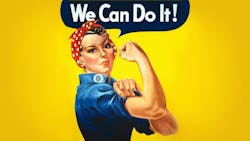In an era in which education and training have never been more important for economic prosperity and success, the U.S. has fallen behind many other nations in educational attainment and achievement. Within the U.S., there is growing evidence of a “skills gap.”
Recently, 82% of manufacturers surveyed by The Manufacturing Institute and Deloitte reported a moderate or serious shortage of skilled workers. Over the next decade nearly 3½ million manufacturing jobs likely need to be filled. The skills gap is expected to result in 2 million of those jobs going unfilled. More than 75% of manufacturers say the skills shortage has negatively impacted their ability to expand and 69% of manufacturers expect the shortage in skilled production to worsen.
About TWIDuring WWII, there was a critical need to train replacements of an industrial workforce that went off to fight the war. It was in that time of crisis when Training Within Industry (TWI) programs proved their worth to help win WW II, and now organizations are turning to TWI again. TWI met two criteria that other training methods couldn’t during wartime. First, the workers had to be trained very quickly, and, second, they had to perform their tasks with consistent quality. The TWI method has multiple components that address skills training, employee relations, continuous improvement, and safety; but the heart of the person-to-person training is the transfer of knowledge in a minimalist format from trainer to student. Using a common “lean” language, TWI levels the flow of training to smooth the transfer of knowledge. Rosie the Riveter and thousands of others were successfully trained using the TWI program: “We Can Do It!” |
Newport News Shipbuilding (NNS), a perennial leader in industrial innovation, is pioneering a new approach to workforce training, combining something "old," an approach called Training Within Industry (see sidebar), with new augmented reality technology.
NNS, an early adopter of the TWI programs during WWII, calls the new application “Augmented TWI.”
Shipbuilding has been the perfect environment for industrial innovation for hundreds of years. Sails to steam, wood to iron, rivets to welds, blueprints to CAD, stick-built to modular construction—all major innovations to building extraordinarily complex vehicles. Newport News Shipbuilding is constantly seeking new technology and innovative ways to improve safety, quality, cost, and schedules. Since 2007, they have explored Augmented Reality as a means to shift away from paper-based documentation in the work environment.
The "Augmented TWI" program is being led by Patrick Ryan the founding leader of the Augmented Reality (AR) Program at NNS. He also leads the development and engineering functions of AR at both NNS and their commercial teaming partner, Index AR Solutions, in Williamsburg, Va.
Mobile AR technologies can create solutions that include step-by-step instructions using visual overlays of the right information on equipment, machine, and panel operations. AR solutions visually enhance a worker’s access to information required to perform a job including steps, cautions, knowledge from expert workers, schematics and any other digitized data. It provides seamless and timely transfer of knowledge and key points to workers on the job.
AR overlays digital information onto the physical world through a window—like an iPad. In shipbuilding, the potential applications are enormous, including comparing a 3D product model to its physical counterpart, planning and training for future work, step-by-step maintenance instructions, and highlighting potential safety concerns.
AR delivers more information in an intuitive way—making every shipbuilder and sailor more knowledgeable and capable. “Augmented Reality should be employed first in places where it creates the most value—and that actually can be subjective,” states Ryan. “Sometimes, this is helping people become more efficient and working more quickly, sometimes this is about helping to reduce errors and rework, and sometimes it is all about improving safety.” The new generation of Rosie’s will use all forms of new technology and mobile devices to be faster at winning the global economic race.
The Training Within Industry Institute has actively participated with Newport News Shipbuilding and other leading organizations across the globe to help them deploy the TWI Programs. This new Augmented TWI application can be the answer to making businesses more competitive faster so they and their workers can maintain America’s standing as the world’s leading manufacturing powerhouse.
The core of the TWI process is the ability to quickly teach a person a new skill or job correctly, safely and conscientiously. “Couple this process with the emerging technology of AR and you create a training and skills transfer platform that is unequaled,” states Scott Curtis CEO of CNYTDO and president of TWI Institute. “Getting the job done right the first time, every time is no longer an unreachable goal.”
Using TWI and AR will tap in to the hidden talent of the existing workforce. Additionally, AR breaks down very complex designs and fabrications into manageable and achievable tasks without trial and error and all of the waste and cost associated with traditional methods.
"The power of TWI is its impact of developing people in any organization—regardless of the industry, at any level in the organization—to have a fundamental skill, behavior, and ability to solve problems at an accelerated pace and at a more effective level," says Jim Huntzinger, President and Founder of Lean Frontiers. He further explains, “As this pattern of skills traverses the organization, this problem-solving skill reaches all facets of the business, which substantially improves the organization’s competitiveness and increases the value and capability. Companies which have continued to mature in their use and deployment of TWI have created improvements in areas they would have never realized under traditional means. Significant competitive value and improvements have become their reality.”
To learn more about Augmented TWI and engaging people consider attending the TWI & LEAN HR Summit May 12-13, 2016, in San Antonio, Texas.
Glenn Marshall, a retired Newport News Shipbuilding executive, is the AME Chair, Manufacturing As A Career Path. This article is based on a NNS presentation at the AME International Lean Conference last fall.
